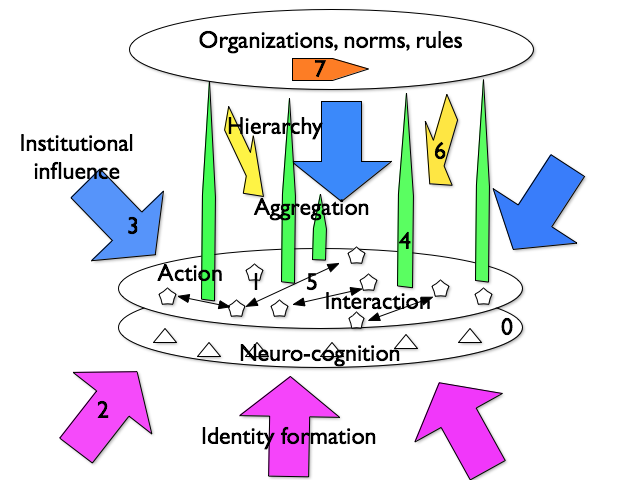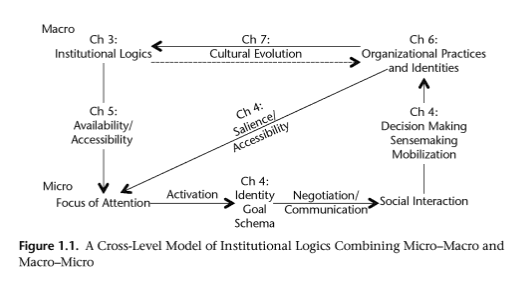Social Sciences

If we are going to take social mechanisms seriously, we need to be able to say more about what they are. Earlier posts have opened the possibility of offering a scheme of classification for social mechanisms (link, link). Here I want to briefly explore a different idea: to group mechanisms according to which part they play within the space of social influence postulated by the idea of methodological localism (link). I introduced the idea of methodological localism in "Levels of the Social" (link) as an ontological alternative to both methodological individualism and methodological holism. That specification of the nature of social reality suggested a small handful of fundamental questions. Here I want to experiment with classifying a number of mechanisms according to which of these questions they answer. Here is the relevant statement from "Levels of the Social" (link):
According to methodological localism, the social is constituted by socially situated individuals, nested within social relations and institutions that have only an intermediate degree of persistence and permanence.
This is a "functional" taxonomy of mechanisms; it classifies social mechanisms according to what they do. A different scheme would be to group mechanisms according to how they work: rational choice, game theoretic, social network, sub-cognitive, group dynamics, collective action, coercion, epidemiological, .... If we adopted both schemes, then we would arrive at a two-dimensional classification including both functional location and mode of activity.
So how does this scheme mesh with the mechanisms singled out in my earlier post? Here is a grouping of the mechanisms included in the catalogue presented there according to the current scheme:
0.00 NEURO-COGNITIVE SYSTEM
- The January 2015 Issue Of Research Development And Grant Writing News Has Been Posted
Colleagues: for those of you interested in news and help about and with grant writing, this is an excellent source. Please do take a look at it. The January 2015 issue of Research Development and Grant Writing News has...
- Macarthur Foundation Housing Research Proposals
Today, The MacArthur Foundation issued a request for housing research proposals as part of its How Housing Matters to Families and Communitiesprogram, a five-year, $25 million research initiative to deepen the literature on the effect...
- Rrc Meeting - Library And Information Services : Growing Global Trends
RANGANATHAN RESEARCH CIRCLE(An organ of Ranganathan Research Trust, Regd.:25953, 1995)J8/123, Rajouri Garden, New Delhi Date ...
- Invitation To Attend A Seminar At Nassdoc On 10.12.2012 @ 5 Pm
Society for Library Professionals (SLP) andNational Social Science Documentation Centre (NASSDOC), ICSSRCordially invite you to attend a SeminarSpeaker:Kanako Sakai (Ms.)Institute of DevelopingEconomies-JETROChiba, JapanTopic:IDE...
- 119th Birthday Celebration Of Dr. S.r. Ranganathan
RANGANATHAN RESEARCH CIRCLE(An organ of Ranganathan Research Trust, Regd.:25953, 1995)J8/123, Rajouri Garden, New Delhi _________________________________________RANGANATHAN RESEARCH CIRCLECordially invites you to the 119th Birthday...
Social Sciences
Classifying mechanisms by location

If we are going to take social mechanisms seriously, we need to be able to say more about what they are. Earlier posts have opened the possibility of offering a scheme of classification for social mechanisms (link, link). Here I want to briefly explore a different idea: to group mechanisms according to which part they play within the space of social influence postulated by the idea of methodological localism (link). I introduced the idea of methodological localism in "Levels of the Social" (link) as an ontological alternative to both methodological individualism and methodological holism. That specification of the nature of social reality suggested a small handful of fundamental questions. Here I want to experiment with classifying a number of mechanisms according to which of these questions they answer. Here is the relevant statement from "Levels of the Social" (link):
According to methodological localism, the social is constituted by socially situated individuals, nested within social relations and institutions that have only an intermediate degree of persistence and permanence.
The socially situated individual finds herself within a concrete set of social relationships, networks, and institutions. This complex serves to socialize and provide incentives, as well as to constrain. The approach of methodological localism supports as well the reality that institutions often have extra-local scope, geographically, demographically, and administratively. So, we can legitimately describe institutions with broader scope as being ?higher-level? institutions.
This approach suggests six large areas of focus for social science research:
- What makes the individual tick? [action mechanisms]
- How are individuals formed and constituted? [social constitution mechanisms]
- What are the institutional and organizational factors that motivate and constrain individuals' choices? [institutional mechanisms on individual behavior]
- How do individual agents' actions aggregate to higher-level social patterns? [aggregative mechanisms]
- How do macro-level social structures influence other macro-level social structures? [meso-meso mechanisms]
0 neuro-cognitive systemI have represented these eight zones in the messy figure above.
1 action and deliberation
2 identity formation
3 institutional influence on individuals
4 aggregation from individual to social
5 social action and collective action
6 hierarchy and control
7 meso-meso influences
This is a "functional" taxonomy of mechanisms; it classifies social mechanisms according to what they do. A different scheme would be to group mechanisms according to how they work: rational choice, game theoretic, social network, sub-cognitive, group dynamics, collective action, coercion, epidemiological, .... If we adopted both schemes, then we would arrive at a two-dimensional classification including both functional location and mode of activity.
So how does this scheme mesh with the mechanisms singled out in my earlier post? Here is a grouping of the mechanisms included in the catalogue presented there according to the current scheme:
1.00 ACTION AND DELIBERATION
1.01 Altruistic enforcement
1.02 Conditional altruism [individuals reason on the basis of conditional willingness to act in support of collective good]
1.03 Reciprocity [individuals act for other individuals in expectation of return favors in future; successful only in specific social conditions]
1.04 Social appropriation
1.05 Stereotype threat
2.00 IDENTITY FORMATION
2.01 Boundary activation
2.02 Certification
2.03 norm inculcation
3.00 INSTITUTIONAL INFLUENCE ON INDIVIDUALS
3.01 Audit and accounting [organization establishes rules and roles to oversee compliance with policies]
3.02 Broadcast
3.04 Contract
3.05 Employee training [organization establishes training for employees to encourage or create desired forms of behavior]
3.06 Framing [leaders communicate issues and demands to followers in favorable ways]
3.09 Morale building
3.10 Norms [normative community influences individual action and choice]
3.11 Selective benefits [organization or club offers benefits to those who contribute to joint actions]
3.12 Selective coercion [group, leaders! or members impose sanctions on members to enforce compliance with group rules]
3.14 Supervision
3.15 Regulatory organizations
4.00 AGGREGATION OF INDIVIDUAL TO SOCIAL
4.02 Auction
4.03 Cyclical voting
4.04 Democratic decision making
4.05 Erosion
4.06 Flash trading
4.07 Imitation
4.08 Influence peddling
4.09 Interlocking mobilization
4.10 Interpersonal network
4.01 Market
4.13 Market for lemons
4.15 Producers' control
4.16 Rumor
4.17 Subliminal transmission
5.00 SOCIAL ACTION AND COLLECTIVE ACTION
5.01 Agenda setting
5.01 Brokerage [leaders negotiate coordinated action with other groups/leaders]
5.02 Convention [individuals coordinate action around conspicuous patterns or rules]
5.03 Coordinated action
5.04 Escalation [group and leaders promote broader action alliance or elevate level of action]
5.05 Free rider behavior
5.06 Prisoners' dilemma [result of strategic action among two or more players]
5.08 Person-to-person transmission
5.08 Person-to-person transmission
6.00 HIERARCHY AND CONTROL
6.01 Control of communications systems
6.02 Deception
6.03 Informers
6.03 Charisma
6.03 Charisma
6.04 Propaganda
6.05 Secret police files
6.06 Spectacular use of force
6.07 Leadership
6.08 Ministry direction
6.07 Leadership
6.08 Ministry direction
7.00 MESO-MESO INFLUENCE
7.01 Competition for power [groups and leaders take steps to improve their power position]
7.02 Diffusion [example of collective action spreads to other locales and groups and issues]
7.03 Non-linear effects within social networks
7.04 Overlapping systems of authority (Brenner)
7.05 Transport networks
Interestingly enough, here is a rather similar diagram (in structure, anyway) that is provided by Thornton, Ocacio, and Lounsbury in their presentation of the field of "institutional logics" (The Institutional Logics Perspective: A New Approach to Culture, Structure and Process):
 If we understand each of the arrows as a group of mechanisms, extending influence from one zone to the other, the diagram is very similar in its logic to the one provided above.
If we understand each of the arrows as a group of mechanisms, extending influence from one zone to the other, the diagram is very similar in its logic to the one provided above.

- The January 2015 Issue Of Research Development And Grant Writing News Has Been Posted
Colleagues: for those of you interested in news and help about and with grant writing, this is an excellent source. Please do take a look at it. The January 2015 issue of Research Development and Grant Writing News has...
- Macarthur Foundation Housing Research Proposals
Today, The MacArthur Foundation issued a request for housing research proposals as part of its How Housing Matters to Families and Communitiesprogram, a five-year, $25 million research initiative to deepen the literature on the effect...
- Rrc Meeting - Library And Information Services : Growing Global Trends
RANGANATHAN RESEARCH CIRCLE(An organ of Ranganathan Research Trust, Regd.:25953, 1995)J8/123, Rajouri Garden, New Delhi Date ...
- Invitation To Attend A Seminar At Nassdoc On 10.12.2012 @ 5 Pm
Society for Library Professionals (SLP) andNational Social Science Documentation Centre (NASSDOC), ICSSRCordially invite you to attend a SeminarSpeaker:Kanako Sakai (Ms.)Institute of DevelopingEconomies-JETROChiba, JapanTopic:IDE...
- 119th Birthday Celebration Of Dr. S.r. Ranganathan
RANGANATHAN RESEARCH CIRCLE(An organ of Ranganathan Research Trust, Regd.:25953, 1995)J8/123, Rajouri Garden, New Delhi _________________________________________RANGANATHAN RESEARCH CIRCLECordially invites you to the 119th Birthday...
